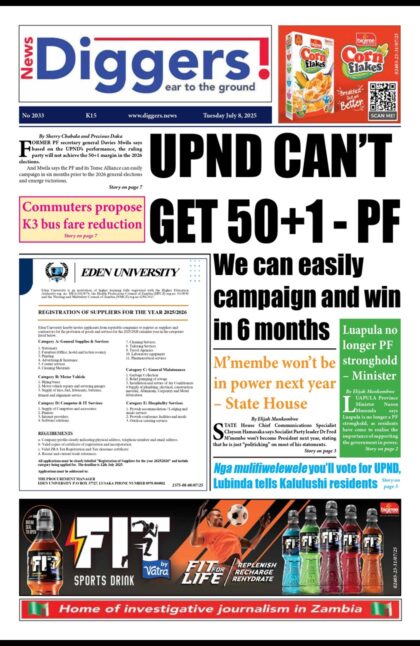GOVERNMENT still needs to implement strong fiscal policy where the budget deficit and high levels of inflation are kept under control if the Bank of Zambia’s (BoZ) relaxed monetary policy is to have any meaningful impact, says economist Chibamba Kanyama.
And Kanyama says interest rates on loan facilities should not be expected to significantly decline despite the slashed benchmark policy rate of eight per cent due to the elevated risk levels associated with COVID-19.
But Kanyama has hailed the now former BoZ governor Dr Denny Kalyalya for being courageous and taking decisive action to cut the Monetary Policy Rate (MPR) to a historic low in a bid to safeguard Zambia’s financial system stability and protect people’s livelihoods.
In an interview, Thursday, Kanyama observed that while the reduced MPR of eight per cent was a welcome development to cushion the impact of the Coronavirus on the country’s economy, he stressed that government still needed to focus on implementing strong fiscal policy.
He cautioned that high inflationary pressure remained a grave threat towards full economic recovery, which required strong fiscal discipline to rein in high inflation.
Last Wednesday, the central bank slashed the benchmark policy rate by 125 basis points to 8 per cent from 9.25 per cent in a bid to safeguard the country’s financial stability to offset the devastating effects of COVID-19, as cases look set to continue rising, the second successive rate cut this year and the lowest MPC rate historically.
“Now, we are talking about inflation standing at 15.8 per cent and then you are lowering the policy rate. When inflation is that high, the response is to treat this disease because the real cancer we have to fight right now is inflation, and even if you improve liquidity, the way the BoZ wants to improve liquidity, increase credit to the private sector, reduce interest rates to improve consumer borrowing, but the pocket power has been compromised because they (consumers) are not going to fetch as much as they fetched last year; the same amount of money is going to fetch less because inflation is high. That is what worries me now,” Kanyama said.
“So, the BoZ is really facing a very difficult situation whether to target inflation and bring it down because we all expected that inflation by this time of the year will be around where it should be when there is food crop in the system, but it has stalled, and we are coming to the end of the year. So, the real threat to private sector growth is inflation. Unless we have strong fiscal discipline, this is where it really matters. Managing expenditure, managing our debt levels…we will continue to second-guess monetary policy as to where it will trigger growth.”
He said interest rates on loan facilities might not significantly decline despite the slashed benchmark policy rate of 8 per cent where commercial banks would resist cutting lending rates due to the elevated risk levels associated with COVID-19.
“The real threat to the private sector right now is inflation and the fiscal deficit because government is going to the (financial) market to borrow money and at the same time, the private sector is going to the same market so interest rates may not even come down as we thought because there is competition out there. Government is going to look for the dollar to service the debt and the same private sector is going to the market to look for dollars to import machinery, raw materials…what happens? The exchange rate is shooting up! Compromising growth of the private sector,” Kanyama charged.
“In the nominal (lending) rates, we will see some kind of decline and that is supported by the K10 billion (BoZ Refinancing Facility) pumped into the system because that one has got some ceiling of 17.5 per cent. So, as a result, the commercial banks are faced with this competition: the BoZ money, which the same commercial banks have to lend at 17.5 per cent and their own money, which they have to lend at about 30 per cent. So most of their clients are going for this other money, and that is what has contributed to what you are observing now. But, also, remember that this is nominal, the real interest rates have still remained as high as they should be; if anything, the private sector risks under COVID-19 have increased so the potential of companies defaulting is higher than ever before. That is factored into the pricing of money by commercial banks.”
Kanyama, the Bridges Limited chief executive officer, hailed Dr Kalyalya, who was dismissed by President Edgar Lungu, Saturday, for being courageous and taking decisive action to cut the benchmark policy rate to a historic low in a bid to safeguard Zambia’s financial system stability and protect people’s livelihoods.
“The governor means well! And I must congratulate him, he is a very courageous man, he is trying to score as many goals as possible to ensure he wins the game. But, unfortunately, in the economic equation, he is not alone; monetary policy alone can never sustain the economy; monetary policy is a stabiliser to allow fiscal policy to ignite growth,” said Kanyama.
“In terms of stabilising the financial system, the central bank has done very well, and I really congratulate the central bank because they have been very truthful on the actual reality of the economy; they have been very truthful about what should be happening in this country; their focus is on ensuring stability.”
Zambia’s budget deficit has leaped to K17.2 billion from K14.8 billion announced in April largely attributed to a reduction in economic activity, according to Ministry of Finance data, as the country’s debt levels remain elevated.
Last month, Finance Minister Dr Bwalya Ng’andu unveiled his second successive supplementary budget worth an unprecedented K15.01 billion; with K5.7 billion earmarked towards debt servicing, representing around 38 per cent of the total budget, while K5.5 billion will be allocated towards expenditure drawn from the COVID-19 bond, leaving only K3.9 billion remaining to fund other government functions.
On the other hand, the foreign exchange market has so far remained unresponsive to the benchmark policy rate cut as markets closed at K19.10 per dollar from an opening of K18.98, Friday.



















